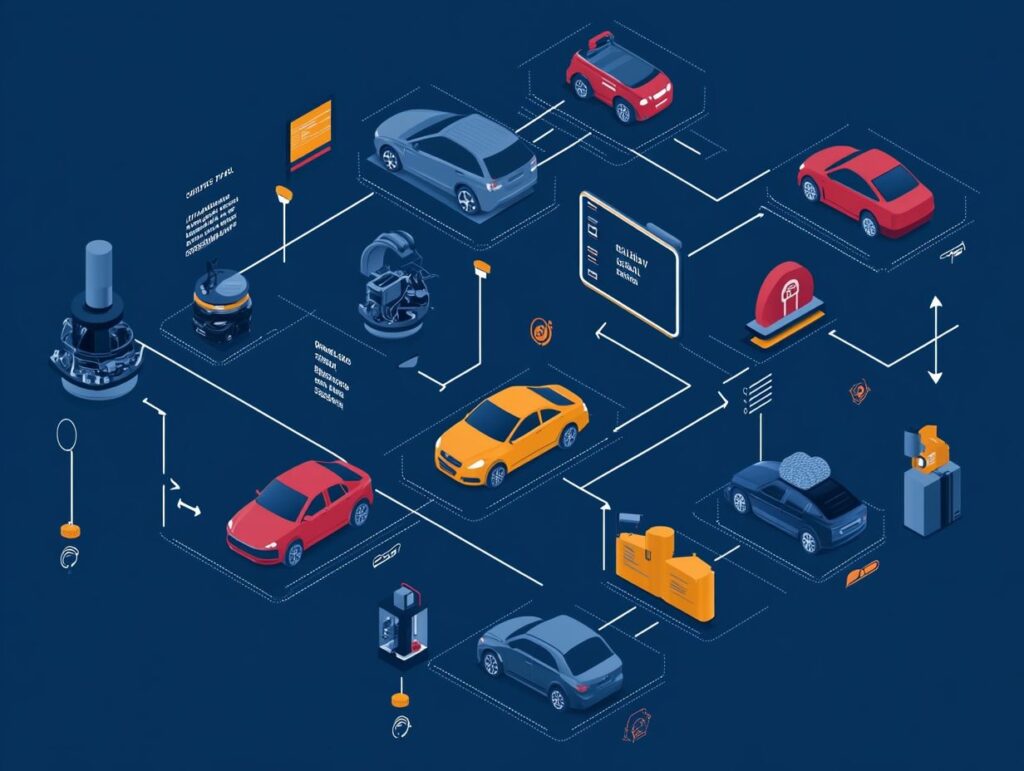
In the fast-paced realm of auto detailing, efficiency plays a crucial role in achieving success. It is essential to understand business workflows to streamline operations and enhance customer satisfaction.
This article delves into the significance of implementing effective workflows specifically designed for auto detailing businesses. We will guide you through the essential steps, from identifying key processes to mapping them out and refining them, all aimed at creating a seamless workflow.
Throughout this journey, we will share best practices and address common challenges, ensuring you are well-equipped to optimize your business for growth and productivity.
The Importance of Implementing Workflows

Implementing workflows is crucial for any business seeking to improve efficiency and enhance customer satisfaction. Workflows promote consistency in service delivery, ensure compliance with quality control standards, and enable teams to manage their tasks effectively, ultimately leading to improved performance metrics.
For instance, in the auto detailing industry, well-structured workflows streamline the detailing process—from appointment scheduling to project management. This not only enhances the client experience but also elevates the overall quality of service provided.
Benefits for Auto Detailing Businesses
Auto detailing businesses can greatly benefit from implementing effective workflows, as these structured processes enhance customer service and streamline the detailing experience.
By defining specific workflow steps, detailing companies can create efficient service packages that cater to various customer needs while ensuring that employees receive proper training to uphold high standards.
For example, a well-designed workflow can automate appointment scheduling and send reminders, which helps reduce no-shows and boosts customer satisfaction. Additionally, by clearly outlining each step of the detailing process—from the initial inspection to the final quality checks—employees can work with greater speed and precision.
This clarity also streamlines employee training, allowing new staff to quickly get acquainted with established protocols.
Ultimately, these workflows not only improve operational efficiency but also cultivate a culture of consistency, leading to stronger customer loyalty. Clients feel valued and well-served when they receive personalized service packages tailored to their preferences.
Steps for Creating Effective Workflows
Creating effective workflows entails several essential steps that assist organizations in optimizing their operations and achieving their business objectives.
The process starts with identifying key tasks and processes, which can differ significantly based on the industry and specific organizational needs. For example, in the auto detailing sector, well-structured workflows can greatly enhance vehicle maintenance and service delivery.
By adopting best practices for workflow optimization, businesses can streamline their operations, leading to a more organized and efficient environment. Additionally, integrating process automation can help reduce manual errors and boost overall productivity.
Identifying Key Processes and Tasks

Identifying key processes and tasks is a crucial first step in creating effective workflows, as it establishes the foundation for streamlining operations. In the realm of auto detailing, this might involve pinpointing essential workflow steps such as appointment scheduling, equipment setup, and inventory management for detailing supplies.
By clearly defining these processes, businesses can enhance project management and allocate resources more effectively, ultimately maximizing efficiency and achieving their desired outcomes.
For instance, mapping out the detailing process can ensure that each task—ranging from washing to waxing—follows a logical sequence. This approach not only prevents wasted time but also reduces the chances of overlooking important steps.
During equipment setup, detailing professionals can verify that all necessary tools are in place and functioning correctly, which helps avoid delays during the detailing session.
Moreover, efficient inventory management facilitates timely restocking of supplies, ensuring that workers have everything they need at the right moment.
By implementing these structured strategies, auto detailing businesses can significantly enhance their service quality and improve customer satisfaction.
Mapping Out the Workflow
Mapping out the workflow is an essential step that allows for a clear visualization of the entire process, ensuring that each task is aligned for optimal efficiency.
By creating a visual representation of the workflow, detailing businesses can identify potential bottlenecks and areas that need improvement, ultimately leading to enhanced productivity. This mapping process should cover all aspects of the detailing operation, from initial client communication to the final quality control checks, which facilitates workflow optimization and effective task delegation.
It’s crucial to understand how each step contributes to the overall detailing project in order to maintain a high standard of work. By carefully charting the detailing process, companies can identify specific stages—such as wash, polish, and seal—where delays may arise.
This visualization not only improves communication among team members but also fosters a culture of continuous improvement. With a well-mapped workflow, businesses can become more agile, adapting to customer needs without compromising quality. This results in a smoother operation, ultimately enhancing client satisfaction and loyalty.
Implementing and Refining the Workflow
Implementing and refining workflows is an ongoing endeavor that requires businesses to continually assess their operations and adapt to changing circumstances. In the auto detailing industry, this entails regularly evaluating the effectiveness of the detailing process and making necessary adjustments to improve quality control and enhance customer satisfaction.
By analyzing performance metrics, businesses can identify areas for improvement and implement changes that optimize workflows for even better outcomes.
For example, an auto detailing shop might track the time taken for each service type and correlate that data with customer feedback to identify potential delays or quality issues. By establishing benchmarks and utilizing these performance metrics, they could refine their processes—such as training staff on more efficient polishing techniques or investing in superior equipment.
This commitment to continuous improvement in workflows not only enhances efficiency but also ultimately boosts customer retention and loyalty, as clients consistently receive high-quality services. Businesses that adopt this iterative approach position themselves to remain competitive in a rapidly evolving market.
Best Practices for Business Workflows
Adhering to best practices is crucial for maximizing the effectiveness of business workflows and ensuring ongoing improvements in efficiency.
These practices can include a variety of strategies, such as:
- Implementing employee training programs to enhance team collaboration
- Performance metrics, especially in industries like auto detailing
By cultivating a culture of continuous improvement and embracing technology integration, businesses can successfully optimize their workflows and elevate their overall service delivery.
Tips for Streamlining and Improving Efficiency

Streamlining processes is essential for enhancing efficiency in any business, and there are several key strategies that can assist organizations in achieving this objective.
One effective approach is to regularly conduct performance evaluations to identify workflow bottlenecks and inefficiencies that require attention, particularly in a dynamic environment like auto detailing. Utilizing technology and automation can greatly improve workflow optimization and reduce labor costs, ultimately leading to higher profit margins and increased customer satisfaction.
To successfully implement these strategies, businesses should begin by mapping out their current workflows. This visualization can help highlight areas that may be impeding productivity.
It may also be beneficial to utilize project management software to ensure that all team members are aligned and to automate notifications, which can save valuable time in communication.
Training staff to use these tools effectively give the power tos them to optimize their own workflows. Additionally, setting measurable goals can steer teams toward continuous improvement, fostering a culture of efficiency and adaptability.
By incorporating these practical tips, organizations can not only streamline their operations but also enhance the overall customer experience, especially in the auto detailing industry.
Common Challenges and Solutions
Common challenges in managing workflows can significantly impact an organization’s ability to optimize operations and deliver quality results. These challenges may present themselves in different ways, including ineffective communication, insufficient employee training, and a failure to meet service standards, especially in industries such as auto detailing.
Nevertheless, by recognizing these issues and implementing targeted solutions, businesses can effectively overcome obstacles and improve customer satisfaction, ensuring that quality control measures are consistently maintained.
Dealing with Roadblocks and Obstacles
Dealing with roadblocks and obstacles is an unavoidable aspect of managing business workflows, and recognizing these issues early is crucial for maintaining efficiency. Common challenges, such as miscommunication among team members or inadequate resource allocation, can significantly hinder progress.
In the auto detailing industry, addressing these roadblocks promptly can lead to enhanced project management, improved customer service, and increased satisfaction levels, all of which contribute to business growth.
These challenges may also arise from insufficient training or outdated technology, further complicating operations and reducing overall productivity. Fortunately, there are effective strategies to address these issues, such as:
- Implementing clear communication channels
- Adopting advanced scheduling tools
- Ensuring the team receives comprehensive training on the latest techniques and equipment
By prioritizing efficiency improvements and proactively addressing workflow challenges, businesses can streamline their processes, reduce stress on their teams, and create a more seamless experience for their customers.
Frequently Asked Questions
What are the essential steps in a business workflow for auto detailers?

The essential steps in a business workflow for auto detailers include: client scheduling, vehicle evaluation, cleaning and preparation, detailing, quality check, and customer feedback.
How can a business workflow improve efficiency for auto detailers?
A business workflow can improve efficiency for auto detailers by streamlining processes, reducing duplication of tasks, and ensuring clear communication between team members.
What are the key factors to consider when creating a business workflow for auto detailers?
The key factors to consider when creating a business workflow for auto detailers are the specific services offered, the target market, the availability of resources, and the desired level of customer satisfaction.
What should be included in a vehicle evaluation for auto detailing?
A vehicle evaluation for auto detailing should include an inspection of the interior and exterior of the vehicle, noting any damages or specific areas of concern, and discussing any additional services the customer may want.
How important is quality control in a business workflow for auto detailers?
Quality control is crucial in a business workflow for auto detailers as it ensures consistent and high-quality services, which leads to customer satisfaction and loyalty.
How can customer feedback be incorporated in a business workflow for auto detailers?
Customer feedback can be incorporated in a business workflow for auto detailers through regular surveys, online reviews, and direct communication with customers. This feedback can be used to improve services and ensure customer satisfaction.
The AutoPros.online team is dedicated to bringing you high quality automotive content for professionals and car enthusiasts, with topics like auto detailing, performance modifiations, repairs and automotive news.



